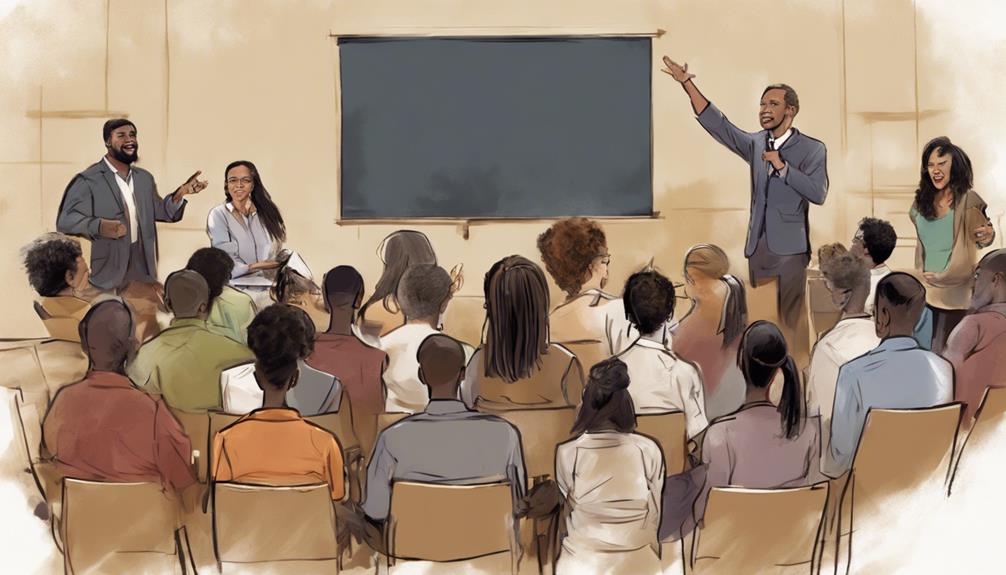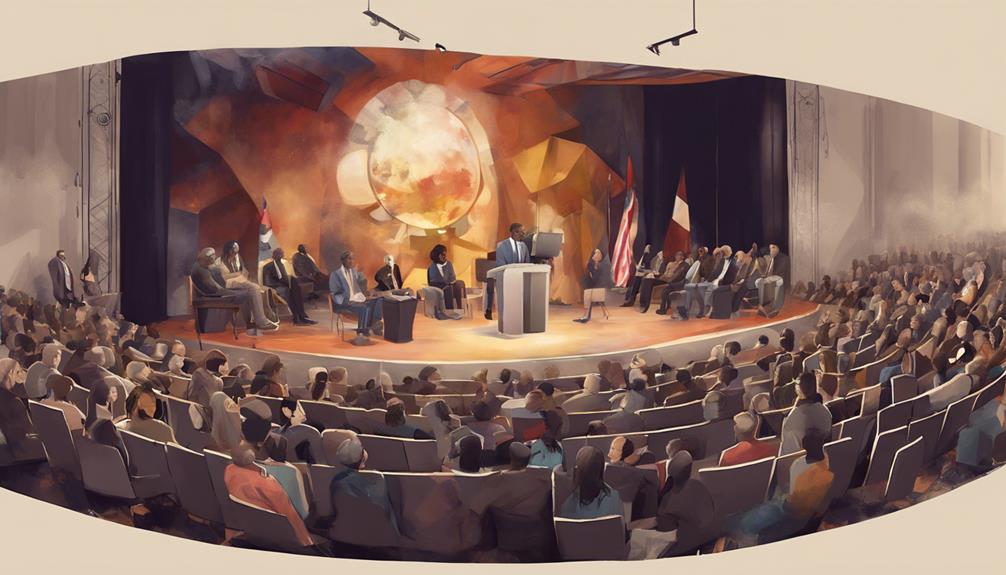To overcome ethnocentrism in public speaking, start by recognizing cultural biases. Promote cultural awareness and embrace diversity to address ethnocentric tendencies. Develop empathy by understanding diverse backgrounds and tailoring messages inclusively. Use language resources, research cultural norms, and practice active listening for effective cross-cultural communication. Embrace diversity in public speaking to enrich the experience, challenge stereotypes, and showcase a commitment to multicultural understanding. Ready to break down barriers and foster stronger connections in your public speaking?
Key Takeaways
- Embrace cultural diversity for enriched public speaking experiences.
- Challenge stereotypes and prejudices through inclusive language.
- Incorporate diverse cultural elements to engage diverse audiences.
- Demonstrate a commitment to understanding and appreciating multiculturalism.
- Foster empathy by tailoring messages to be inclusive and relatable.
Recognizing Cultural Biases
Recognizing cultural biases is vital for effective communication in public speaking with diverse audiences. When presenting to individuals from diverse cultural backgrounds, it's pivotal to be aware of potential cultural barriers that may impede effective intercultural communication.
Misinterpretation of cultural references or jokes can inadvertently alienate audience members and hinder the overall message delivery. By acknowledging and addressing cultural biases upfront, speakers can create a more inclusive environment that fosters understanding and connection.
Cultural insensitivity in public speaking not only risks alienating audience members but also perpetuates stereotypes and prejudices. Embracing cultural diversity, on the other hand, enriches presentations by incorporating varied perspectives and experiences.
This inclusivity not only enhances the audience's engagement but also demonstrates respect for the diverse backgrounds present in the audience. By recognizing cultural biases and actively working to overcome them, speakers can promote a more inclusive and effective communication environment in their public speaking engagements.
Addressing Ethnocentric Tendencies

When addressing ethnocentric tendencies in public speaking, it's vital to actively work towards promoting cultural awareness and embracing diversity. Cultural differences play a significant role in shaping communication barriers that can impede effective public speaking. By recognizing and respecting these differences, you can create a more inclusive and engaging environment for your audience.
Embracing diversity involves acknowledging the unique beliefs and customs of various cultures, incorporating them into your presentations, and avoiding language or actions that may be perceived as insensitive.
It's important to understand the impact of ethnocentrism on communication to make sure that your message resonates with all audience members.
Developing Empathy for Diverse Audiences

To effectively connect with diverse audiences, understanding their cultural backgrounds, perspectives, and values is vital. Developing empathy for diverse cultures involves recognizing and respecting the differences in beliefs, customs, and communication styles.
By empathizing with diverse audiences, speakers can tailor their messages to be inclusive, relatable, and engaging, promoting effective communication. Empathy allows speakers to take into account the emotions, experiences, and needs of different audience members, leading to a deeper connection during public speaking engagements.
When speakers take the time to understand diverse audiences, it fosters a sense of connection, trust, and openness, creating a more welcoming environment for effective communication to take place. By embracing empathy for diverse audiences, speakers can break down barriers, build stronger relationships, and ensure their messages resonate with individuals from various cultural backgrounds.
Strategies for Cross-Cultural Communication

Understanding effective strategies for cross-cultural communication is essential to breaking down barriers and fostering meaningful connections with diverse audiences. Incorporating language resources like interpreters and translators can greatly enhance the accuracy of communication in cross-cultural settings. In addition, conducting thorough research on cultural norms is vital to avoid unintentionally causing offense during intercultural interactions.
Active listening plays a pivotal role in cross-cultural communication by ensuring understanding and engagement. By listening attentively and empathetically, you show respect for the perspectives and opinions of individuals from different cultural backgrounds.
Additionally, being mindful of body language cues can help you navigate cross-cultural interactions more effectively. Non-verbal communication, such as gestures and facial expressions, can vary widely across cultures, so it's important to be sensitive to these differences.
Embracing Diversity in Public Speaking

Embracing diversity in public speaking fosters a sense of inclusivity and connection among audience members. Acknowledging cultural diversity enhances the overall experience for both speakers and listeners. Here's why embracing diversity is essential in public speaking:
- Cultural Diversity: Incorporating various cultural perspectives into your speech adds depth and richness, making it more relatable to a diverse audience.
- Effective Cross-Cultural Communication: Embracing diversity helps in bridging communication gaps and ensuring that your message resonates with individuals from different cultural backgrounds.
- Challenging Stereotypes and Prejudices: By showcasing the beauty of diversity in your presentations, you can help break down stereotypes and prejudices, fostering a more tolerant and inclusive society.
Incorporating diverse cultural elements into your public speaking not only enriches your message but also demonstrates a commitment to understanding and appreciating the world's multicultural tapestry.
Frequently Asked Questions
How Can We Prevent Ethnocentrism in Public Speaking?
To prevent ethnocentrism in public speaking, embrace cultural diversity, promote awareness, and respect customs. Recognize the impact on audience perception for more inclusive presentations. Endeavor for sensitivity to foster unity and appreciation for diverse perspectives.
How to Overcome the Barriers to Effective Public Speaking?
Overcoming barriers to effective public speaking is like scaling a mountain of doubt. Embrace diverse perspectives, respect cultural nuances, and promote inclusivity to forge strong connections with your audience. Let authenticity be your guide.
How Is Ethnocentrism a Barrier in Communication?
Ethnocentrism acts as a communication barrier by fostering cultural superiority beliefs, causing misunderstandings, and limiting diverse perspectives. Overcoming it involves promoting cultural awareness, embracing diversity, and aiming for inclusivity in public speaking engagements.
How to Overcome Barriers of Intercultural Communication?
To overcome barriers of intercultural communication, you must embrace diversity, practice active listening, and respect different perspectives. Research cultural norms, promote inclusivity, and aim for understanding. By valuing diversity, you enrich interactions and foster meaningful connections.
How Can Overcoming Ethnocentrism Benefit Public Speakers Discussing Diverse Topics?
Public speakers discussing diverse topics can benefit from overcoming ethnocentrism. By understanding and appreciating different cultures and perspectives, politics to poetry speakers can connect with a wider audience. It can also help them avoid unintentional offense and present their ideas in a more inclusive and relatable manner.
Conclusion
To sum up, breaking down ethnocentrism in public speaking is vital for effective communication across diverse audiences. By acknowledging cultural biases, tackling ethnocentric tendencies, and fostering empathy, you can create a more inclusive and engaging presentation.
For instance, envision delivering a speech to a global audience where grasping various cultural norms and perspectives is essential to connecting with everyone in the audience. Embracing diversity in public speaking isn't only a goal but a requirement for successful communication.










